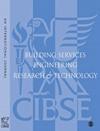带百叶窗的自然通风双层外墙空腔火灾的数值研究
IF 1.8
4区 工程技术
Q3 CONSTRUCTION & BUILDING TECHNOLOGY
Building Services Engineering Research & Technology
Pub Date : 2022-09-28
DOI:10.1177/01436244221129763
引用次数: 4
摘要
双层外墙(DSF),提供绝佳的视野、建筑美学和节能。然而,在火灾事件中,玻璃外墙破裂,导致人员生命危险和消防困难。遮阳装置可防止不利的热量增加,以减少冷却负荷,但可节省能源,这可能会给消防和乘客疏散带来其他挑战。在本研究中,使用火灾动态模拟器(FDS)对一栋空腔内装有百叶窗的多层双层外墙建筑中5MW HRR聚氨酯GM27火灾的蔓延进行了数值研究。百叶窗分别位于距离内部玻璃0.4m、空腔中间和距离外部玻璃0.4m的位置。在每个百叶窗位置,缝翼角度分别为0°、45°、90°和135°。结果显示,峰值内装玻璃表面温度在283°C至840°C之间,具体取决于热电偶位置、百叶窗位置和百叶窗开启角度。在没有百叶窗的情况下,内部玻璃表面的峰值温度在468°C至614°C之间。在所有情况下,除了板条角度为0°且百叶窗位置更靠近外部玻璃时,防火室上方最近热电偶(TC 14)的内部玻璃表面温度超过600°C,即玻璃破裂温度阈值。总的来说,威尼斯百叶窗的位置和百叶窗的开启角度影响了火势的蔓延。未考虑百叶窗的可燃性和可燃性,因此建议在未来进行研究。实际应用:我们的手稿有助于为建筑师、工程师和设计师在双层外墙(DSF)中安装百叶窗时,开发关于降低建筑火灾风险的新思维。本文章由计算机程序翻译,如有差异,请以英文原文为准。
Numerical investigation of fire in the cavity of naturally ventilated double skin façade with venetian blinds
Double skin façades (DSFs), offer great views, architectural aesthetics, and energy savings. Yet, in a fire event the glass façade breaks leading to risks to human life and firefighting difficulties. Shading devices incorporated to prevent unfavourable heat gains to reduce cooling load though offer energy savings potentially present other challenges in firefighting and occupants’ evacuation. In this study, Fire Dynamic Simulator (FDS) was used to numerically investigate the spread of a 5 MW HRR polyurethane GM27 fire in a multi-storey double skin façade building with Venetian blinds placed in its cavity. The blinds were positioned 0.4 m away from the internal glazing, middle of the cavity and 0.4 m away from the external glazing respectively. In each blind position the slat angle was opened at 0°, 45°, 90° and 135° respectively. The results show peak inner glazing surface temperature ranged between 283°C to 840°C depending on the thermocouple position, the Venetian blind position and slat opening angle. Without Venetian blinds, peak inner glazing surface temperatures ranged between 468°C to 614°C. In all cases except when the slat angle was 0° and the blind was positioned closer to the outer glazing, the inner glazing surface temperature from the closest thermocouple (TC 14) above the fire room exceeded 600°C, the glass breakage temperature threshold. Overall, the Venetian blind position and slat opening angle influenced the spread of fire. Venetian blind combustibility and flammability were not considered and therefore recommended for future studies. Practical Application: Our manuscript helps to develop new thinking on mitigation of fire risks in buildings for architects, engineers and designers when incorporating Venetian blinds in Double Skin Façades (DSFs).
求助全文
通过发布文献求助,成功后即可免费获取论文全文。
去求助
来源期刊

Building Services Engineering Research & Technology
工程技术-结构与建筑技术
CiteScore
4.30
自引率
5.90%
发文量
38
审稿时长
>12 weeks
期刊介绍:
Building Services Engineering Research & Technology is one of the foremost, international peer reviewed journals that publishes the highest quality original research relevant to today’s Built Environment. Published in conjunction with CIBSE, this impressive journal reports on the latest research providing you with an invaluable guide to recent developments in the field.
 求助内容:
求助内容: 应助结果提醒方式:
应助结果提醒方式:


